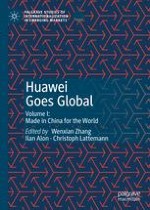Huawei Goes Global provides a much-needed, comprehensive, and scholarly examination of the business environment and the striving global operations of China’s technology giant. With theoretical research, case studies, data analysis, and empirical studies, this two-volume work tells a fascinating story of internationalization in an emerging economy. As one of the most powerful Chinese companies in the global economy, the largest global telecommunications-equipment producer and a leading consumer-electronics manufacturer, Huawei is a great example of the globalization of the Chinese enterprises in the twenty-first century.
In Volume I, scholars critically examine the rise of Huawei as a Chinese global enterprise from the political economy and public policy perspectives, as well as Huawei’s development strategies, innovations, and talent management. In Volume II, multiple authors carefully study the growth of Huawei from regional and geopolitical perspectives, and its corporate communication and crisis management.
Within the framework of the trade conflicts between China and the US, controversies over economic sanctions, intellectual property disputes, and espionage and cyber security concerns, this groundbreaking work makes an important contribution to both academic literature and the ongoing public discourse on Huawei.
Volume II is available here: https://www.palgrave.com/gp/book/9783030475789
